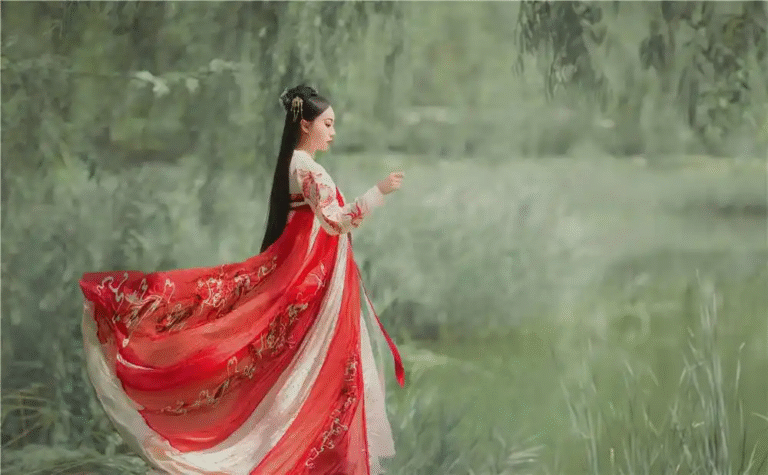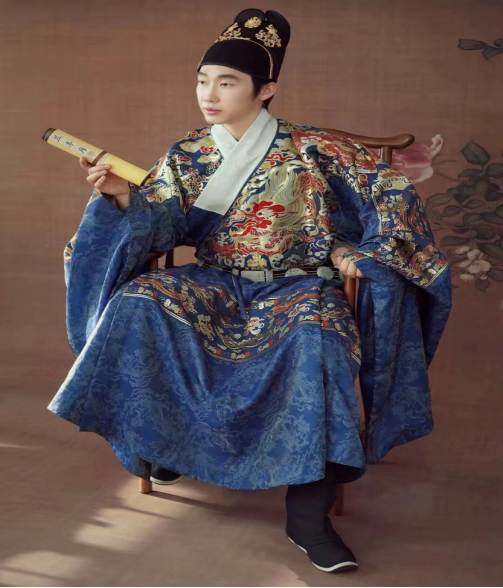Hairstyles have a significant impact on the appearance of Hanfu
Throughout history, people have placed great importance on hairstyles, as they greatly influence one’s external image, especially when it comes to traditional dress like Hanfu. Here, I will take you through five classic Hanfu hairstyles, allowing you to savor the beauty of ancient times.


Hairstyle One: The Cross-Shaped Bun
The Wei and Jin cross-shaped bun starts by dividing the hair into two sections, with the upper section tied into a high bun that resembles a horizontal bar, the lower section left to hang before being gathered into a vertical ponytail. A black satin ribbon is then tied at the crossing point, adorned with a silver filigree lotus crown. This straight-lined hairstyle flatters round faces, when paired with Hanfu, it is recommended to emphasize eyebrows and enhance a cool temperament.


Hairstyle Two: The Twin-Ring Fairy Bun
This iconic hairstyle, originating from the Dunhuang frescoes, showcases the playful charm of Tang dynasty girls with its symmetrical twin rings. The hair is divided in the middle, with each side braided and wrapped into a ring, leaving two wisps of hair beside the temples resembling “fairy whiskers.” Accessorized with gilded flower patterns and pearl drop earrings, the gentle swaying of beads and jade brings to life the poise of women in the “Spinning Silk” painting. A modern simplified version can use hair extensions for assistance, perfect for round faces to highlight a sweet demeanor.


Hairstyle Three: The Three-Strand Bun of the Song Dynasty
The “three-strand head” popular during the Song dynasty,It focuses on presenting a style in which the front hair is level with the eyebrows,the back hair falls down to the shoulders, dividing the hair into three parts: a top bun, hanging hair, and sideburns. Start by tying a high ponytail and coiling it into a round bun, leaving the sideburns to fall naturally, secured with a jade hairpin. It is recommended to pair with a celadon colored hair ribbon and bamboo hairpins, complementing the delicate attire of the Song dynasty. This hairstyle particularly suits long faces, helping to visually shorten the facial proportions.


Hairstyle Four: The Ming Dynasty Elevated Heart Bun
A wedding essential for noble women of the Ming dynasty, this hairstyle requires a base of the “peony bun” topped with decorative elements such as elevated heart, dividing heart, and full crown sets. For convenience, modern simplified versions often use metal hair frames to create a three-dimensional base, adorned with green emerald phoenix hairpins and red coral bead strings. It pairs well with cloud shoulder patches and official robes. When choosing accessories, adhere to the principle of “no more than three,” avoiding excessive accumulation.

Hairstyle Five: The Modern Improved Half-Up Bun
Based on traditional hair tying techniques, incorporate Korean-style half-up hair styling. Gather the hair on the top of the head and coil it into a small bun, and slightly curl the remaining hair. For accessories, choose geometric acrylic hairpins or velvet flowers. When paired with modified Hanfu, you can boldly try gradient-colored hair ends. This hairstyle is especially suitable for modern urban life. It can be quickly styled in five minutes and is appropriate for both commuting and dating, as well as for going out and having fun.

Every traditional Hanfu hairstyle is a cultural expression with unique style. While appreciating the traditional beauty of these hairstyles, you can also master them and incorporate different elements and techniques in modern adaptations, breathing new life into traditional hairdos. Of course, no matter which style you prefer, the most important thing is to choose one that best suits your face shape.







